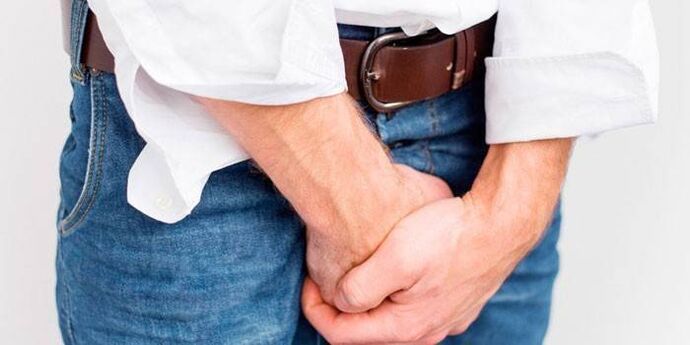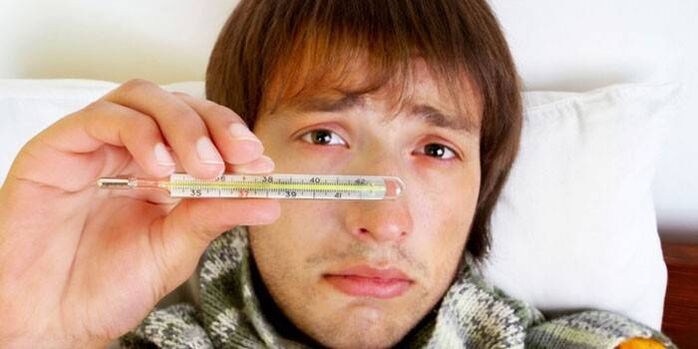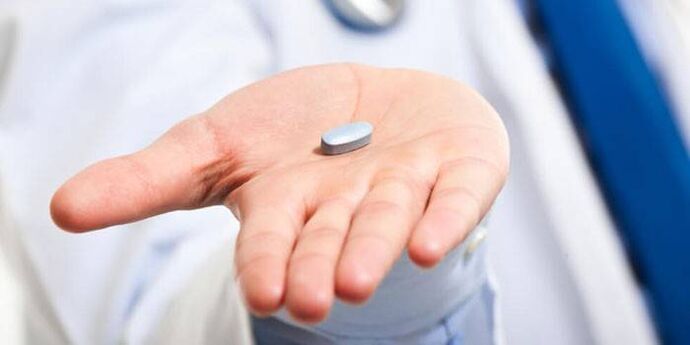Every second man of childbearing age (up to fifty years) is prone to such a delicate disease as acute prostatitis, in which, under the influence of certain factors, the prostate (prostate gland) becomes inflamed and causes various forms of sexual dysfunction, fertility and psycho-emotional states. Pay attention to what your body is saying and don't neglect timely treatment.
What is acute prostatitis
If a man experiences discomfort and even pain when urinating, you should immediately consult a doctor, since acute prostatitis is an infectious etiology that causes inflammation of the prostate, followed by the formation of edema of the glandular tissue and the formation of purulent foci on it. If you do not pay attention to the signs of acute prostatitis, the pathological process can turn into a difficult-to-treat chronic form, and there is very little time to think - the transformation occurs within a few days.
However, more serious complications are possible than the transition to a chronic form. There is a risk of sepsis - a general infection of the blood and ascending infection of the urinary tract with the development of pyelonephritis and cystitis. In these cases, the patient is urgently hospitalized, the condition can be critical. Although sepsis is rare as a complication, it can occur in patients in immunosuppressive states - intoxication, fever, severe symptoms, weakness. Therefore, blood cultures are needed to detect microorganisms.
Symptoms of acute prostatitis
Every man must know and remember the symptoms of acute prostatitis. General signs of the disease are manifested:
- Sharp pain when urinating.
- body poisoning.
- Disturbances in urination (intermittent, weak, strained stream).
- Frequent urge to go to toilet at night.
These are external symptoms of prostatitis, but with a deeper examination, leukocytes, traces of mucus and pus in the secretory fluid of the prostate are found in the urine. When palpating, a dense enlarged organ is felt, pressing is painful. Further development of the inflammatory process is characterized by heaviness and pain in the perineum, radiating to the penis, sacrum and rectum. As a result, it becomes difficult for the patient to empty the bladder and defecate due to severe pain. The body temperature can rise up to 38°C.

Causes of acute prostatitis
Since this disease has a bacterial inflammatory nature, the causes of acute prostatitis are the following infectious agents:
- Gram negative - Klebsiella, E. coli, Proteus.
- Gram-positive - enterococci, staphylococci, streptococci.
- Urogenital - trichomoniasis, chlamydia, ureaplasmosis, gonorrhea, candidiasis, mycoplasmosis.
Microbial microflora usually enter the glandular tissue of the prostate via the transcanalicular route (through the urethra and the prostate ducts). In cystitis, the infection travels from the bladder to the prostate. Other possible pathways for bacterial entry are opened during endurethral manipulations (catheter placement, urethral bougie, cystoscopy, urethroscopy). Pathogenic microorganisms migrate into the prostate from distant pathogen foci in caries, sinusitis, tonsillitis, cholecystitis, pyoderma, bronchitis.
There is a high probability of infection from the intestines with proctitis, hemorrhoidal fissures, colitis. Non-infectious factors that can cause an attack of prostatitis are congestive (congestive) venous phenomena in the pelvic area and impaired drainage of the acini of the gland. Congestion can be caused by irregular or, conversely, excessive sexual activity, cessation of sexual intercourse, sedentary lifestyle, frequent constipation, frequent alcohol intoxication, varicose veins of the small pelvis, hypothermia.
Forms of acute prostatitis
The clinical development of this disease is considered in three stages, which are simultaneously forms of acute pancreatitis. That:
- The first stage is the catarrhal form.
- The second stage is the follicular form.
- The third stage is the parenchymal form.
Acute prostatitis in men begins with catarrhal inflammation, which is characterized by the expansion of the acini, the appearance of edema of the glandular tissue and, as a result, an increase in the size of the organ. The ducts of the prostate glands, which open into the posterior urethra, are actively involved in the inflammatory process. The lobules and ducts of the prostate become inflamed, their contractility is disturbed, they narrow and become clogged, this can complicate the secretion of the prostate secretion.
In the catarrhal stage, the pathological process stops at the layers of mucus and does not go deeper. As the disease progresses, it spreads to the entire prostate. Follicular acute bacterial prostatitis develops. When analyzed in urine, pus is revealed. The tissue of the gland changes destructively, the swelling continues to increase. The follicular form is still amenable to relatively simple treatment.
Also, a parenchymal form of the disease develops, the result of which can be an abscess of the prostate, that is, chronic prostatitis. Hence symptoms like:
- An increase in body temperature to 39 ° C and above.
- Symptoms of intoxication: weakness, chills, thirst, loss of appetite.
- Frequent urges to go to the toilet for small needs are accompanied by throbbing, sharp pains.
- inability to empty the bladder.
- Flatulence.
- tenesmus.
- Constipation.
- Discharge of mucus from the anus.

Diagnosis of acute prostatitis
At the first suspicion of an inflammation of the prostate, go to the doctor quickly. Correct and comprehensive diagnosis of acute prostatitis is very important for quick and successful treatment. First of all, the doctor will analyze the anamnesis, clarify when pain sensations appear in the perineum, whether they increase or decrease during ejaculation, urination, defecation. Be sure that the doctor must study the patient's medical history: what diseases were transmitted, whether there were sexually transmitted infections.
The urologist palpates the external genital organs to determine developmental pathologies, visible signs of prostatitis, and a rectal examination - palpation of the prostate through the anus. In order to create a complete clinical picture, the following examinations must be carried out:
- Urinalysis to determine the level of leukocytes and the presence of purulent threads.
- blood analysis.
- Culture Swab - The contents and scrapings from the urethra are taken to determine the growth of bacteria and their sensitivity to antibiotics.
- Determination of urine velocity (uroflowmetry).
- Ultrasound of the prostate to detect diffuse changes in the gland and its abscess formation.
- A blood test to determine the presence of pathogens such as syphilis, gonorrhea, mycoplasmosis, chlamydia.
- PCR diagnostics.
Treatment of acute prostatitis
After a thorough diagnosis, they begin treatment of acute prostatitis. It is based on antibiotic therapy, the purpose of which is to suppress infectious agents. In addition, conservative treatment of prostatitis includes the use of:
- anti-inflammatory drugs.
- Means that improve blood circulation.
- Painkillers and antispasmodics.
- Drugs that support metabolic processes in the prostate.
- multivitamins.
- phytotherapeutics.
- immunomodulators.
Advanced forms of prostatitis with the appearance of purulent foci require surgical intervention. Transurethral (through the wall of the urethra) or transrectal (through the wall of the anus) drainage of abscessed areas is performed. Surgery may be required for pathological urinary retention. A puncture epicystostomy is performed - an incision is made in the abdominal cavity into which a tube is inserted to drain urine.

drugs
Treatment of acute prostatitis in men with medication (tablets, injections) is the basis of successful therapy. With a well-prescribed antibiotic therapy, the infection can be overcome in a few days. However, it is recommended to continue treatment for four weeks to achieve complete eradication of pathogenic microflora. Medications used in the disease are:
- Etiotrope (antibiotics) - destruction of pathogens.
- Pathogenetic (NSAIDs) - elimination of congestion in the prostate.
- Symptomatic (analgesics, antipyretics) - relieving pain, muscle spasms of the organ and other symptoms.
To treat prostate inflammation, the doctor may prescribe a complex of drugs, which includes:
- Injections - contribute to the penetration of the drug into the body tissues in a short time.
- Candles (rectal) - analgesic, antibacterial effect.
- Instillations - administration of the drug to the prostate through the urethral opening.
- Microclysters with decoctions of herbs.
- Antibacterial drugs with a wide spectrum of action when a specific causative agent of the disease is not identified.
Antibiotics for acute prostatitis
The main causes of prostatitis are pathogenic bacteria that provoke inflammation in the tissues of the prostate. Therefore, in acute prostatitis, antibiotics are the basis of treatment and are prescribed only after testing for sensitivity of microflora. Antimicrobials used in inflammation are divided into the following groups:
- fluoroquinolones.
- penicillins.
- cephalosporins.
- macrolides.
- tetracyclines.
- aminoglycosides.
Prevention of acute prostatitis
In order for a man to always be healthy and full of strength, prevention of acute prostatitis is important, including:
- Regular sex life with a steady partner, excluding casual relationships.
- Use of condoms.
- Quit smoking, drugs, alcohol.
- Right nutrition.
- Personal hygiene.
- Annual check-ups at the urologist.
- Taking vitamins and zinc supplements.
It is important to completely cure diseases of the genitourinary organs (urethritis, cystitis, pyelonephritis, balanoposthitis). Undertreated diseases can cause the development of an inflammatory process in the prostate. Among other things, we must not forget about increasing physical activity. In the cold season, hypothermia should be avoided. Prostate massage is very useful for men's health. However, if the disease has already made itself felt, massage is contraindicated and even impossible due to the pain of the organ.





























